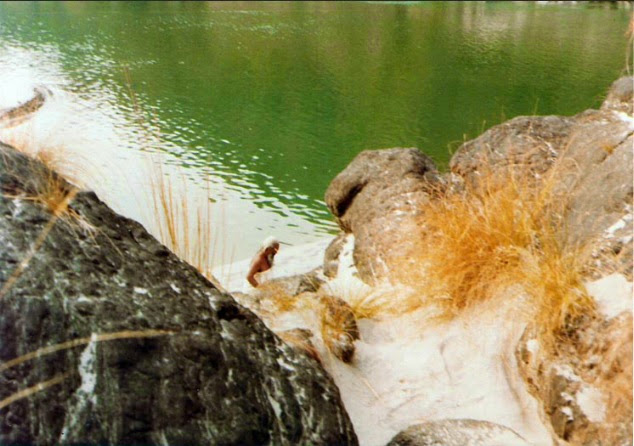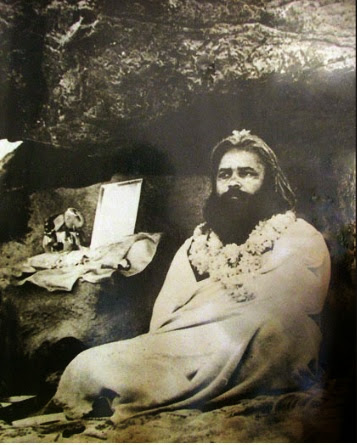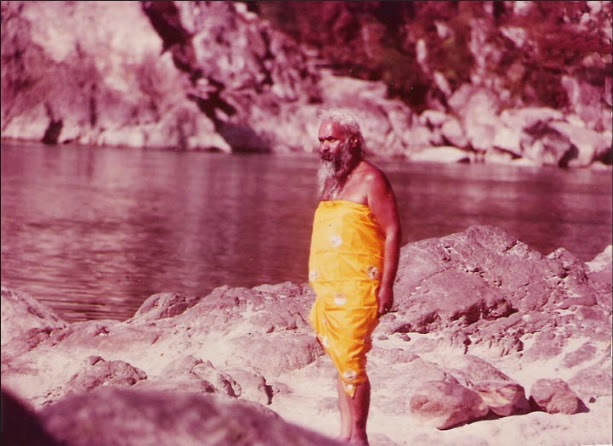Sri Mastram Babaji
A jīvanmukta
When Baba Shri Mastramji was first seen in Rishikesh, no one knew his name or where he had come from but seeing him in a spiritually inebriated state people began to call him ‘Mastram’. Babaji was an Avadhoot Saint as he had shaken off all worldly attachments and connections. This could be seen from the manner in which he lived his life. The word ‘avadhoot’ means ‘shaken off’. He was a jīvanmukta and as a consequence of his embracing austere renunciation, he instinctively lived his life in a state of anonymity. When a person realises that he is one with the Supreme Consciousness, he is called a jīvanmukta. A jīvanmukta is defined in the following verses of Vivekacūḍāmaṇi of Śrī Śankarācāryā :

He is said to be a jīvanmukta whose mind is firmly established, whose bliss is uninterrupted and to whom the world is like a thing forgotten.

He who does not reminisce about the past, does not feel concerned about the future and remains indifferent about what befalls him at the present moment, is said to be liberated while living.

Unlike Swami Ramkrishna Paramahamsa, Maharshi
Raman and other spiritual personalities, no opportunity arose
which could serve as a catalyst to gain familiarity with the
past life of Babaji, his parents or his native place. Since little
is known about his past life, and since he rarely mentioned
anything which could throw any definitive light on the location
or specifics of his earlier life, that has for the most part
remained hidden and we know little about him before became
known to people in Rishikesh.
What we know about him in Rishikesh is that before he had moved, probably in early sixties, to Hanuman Shila, midway between Ramjhoola and Lakshmana Jhoola, he used to sit under a banyan tree near the Vanaprastha Ashram in Swarg Ashram or on the ghat near Gita Bhavan. His arrival in the Hanuman Shila region in the early sixties is inferable from the book entitled Śrīmadbhagavadagītā Mastabhāṣya (681 pages) in which daily discourses of Babaji from 9-12-65 to 28-3-67 are given, as these discourses were delivered at Hanuman Shila. It is known from Babaji’s earliest devotees that prior to 1968 he used to stay near Hanuman Shila before the rains began and during the rainy season he used to go to Badrinath barefooted with a single cotton chadar on his person. From 1969 onwards he did not go to Badrinath but remained in the Hanuman Shila region. In the summer afternoons he used to rest in the shade of Hanuman Shila but in winter he sat there on the beach in the sun. Babaji seemed to very much like to lie on the sand of the Ganga. The place where Babaji sat near the Hanuman Shila was known as the ‘Math’ with Hanuman Shila overlooking it.

At night he slept under this or that boulder. In the beginning, he stayed in a cave adjacent to the Hanuman Shila but later he made the present cave his dwelling place. He ceased to stay there in the rainy season since it was inundated with water. At the approach of navaratra, the cave was again renovated with earth and cowdung. There was a terrace at the entrance of the cave where, in the evening, devotees used to sit in front of Babaji. At his Ashram there was also the ‘Dharmashala’, which was made with wooden sleepers and tarpaulins without the use of brick and cement. This Dharmashala acted as a hall for Satsang. In the mornings and late afternoons Babaji used to sit with visitors sitting on his right and left. Most of the time silence reigned in his presence. He occasionally spoke in response to the questions of visitors and sometimes elaborated the points raised by them. There was a small prefabricated hut that served as a Devi temple during navaratra while the Shivalingam which Babaji had set up with his own hands was worshipped outside under a tree.

An Event In Babaji’s Life
It might be pertinent here to give an account of an event in Babaji’s life which is illustrative of his life of supreme renunciation and firm abidance in the Highest Truth. Once when Babaji was about to take a bath in the Ganga near Banares, he had to wade through marshy water in order to reach the main current of the river. At that time, he was stung by a poisonous fish, known in that area as Sakuchi. A group of villagers who were standing nearby understood that Babaji had been stung by the fish and told him that the fish is very poisonous. They explained that the sting is very painful and very difficult to cure. In fact the only way to heal the wound was to apply a red hot iron to the wound. The villagers suggested that Babaji should stay there for three consecutive days so that they could treat the sting for him to avoid further complications. Babaji allowed them to heat an iron rod and apply it to the wound. As the flesh sizzled, Babaji felt the glowing iron to be cool like sandal wood and he experienced relief from the pain of the sting. As Babaji refused to go to their village with them the villagers then left him alone telling him that they would return in the morning to repeat the treatment. At that time Babaji followed a rule of not staying in one place for more than one night so in the early morning he slipped away before the villagers arrived and continued on his wanderings. The wound did not heal and soon began to fester. In this condition Babaji continued on foot for about 800 miles but because of the septic wound he began to suffer from fever. One night while Babaji sleeping on a beach, attracted by the smell of the wound, a jackal came near to him and bit into the festering flesh. Babaji made no attempt to stop the jackal although it ran off when it realized that Babaji was alive. The saliva of the animal seemed to have a healing effect and the wound began to dry up leaving a huge scar just above Babaji’s ankle. We can understand from this event that since Babaji was a sannyasin, he did not try to get the wound medically treated in a normal way by staying in the village for a month as the villagers requested because if he had done so it would have gone against the obsevances of a sannyasin.
Such a story helps us to see that Babaji lived his life as an exemplary sannyasin who never wavered from his path of renunciation.
This website which is devoted to Babaji has been set up to disseminate his spiritual message and to invite people to share their ideas and discuss their spiritual quests.
Ashram
HANUMANSHILA, SWARG ASHRAM, RISHIKESH,
UTTARAKHAND.
Call Us
09810710693
Write To Us
srimastrambabajii@gmail.com
